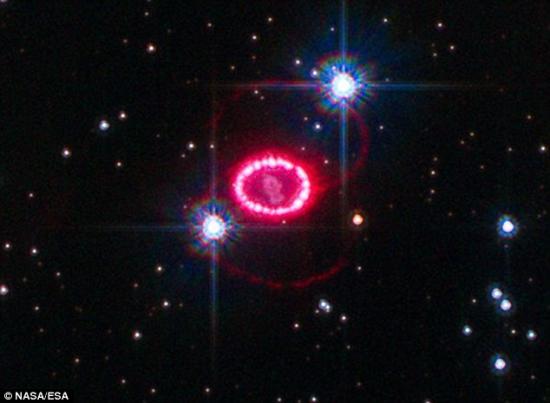据英国《每日邮报》8月9日报道,根据一项最新天文研究显示,当一颗恒星以猛烈超新星形式死亡时,其行星系统内的行星可能会被巨大的力量弹出离开原来的轨道,漫游在星系中而幸存下来。科学家预测,这种幸存下来的行星很可能孕育外星生命。
据悉,至少是太阳7-10倍质量的恒星才能演变成为超新星,这股强大的恒星爆炸可以使任何内部行星陷入混乱之中。这些行星有的烧焦被吞并,有的稳定环绕在超新星残骸周围的轨道上,有的则被弹至更遥远的太空轨道。位于行星系统边缘的行星更容易被抛离,在其它几颗恒星的引力作用下没有固定的运行轨道,形成自由运行的行星。
来自英国剑桥大学的天文学家迪米特里•薇拉斯(Dimitri Veras)是该研究项目负责人,他说:“由于每颗恒星都将死亡,因此将足以引发大量行星被喷射,从而在星系中可形成大量自由行星。观测证据显示:在恒星之间自由漂浮的行星数量远超过环绕其轨道的行星。” 据报道,至2011年5月,一支天文学家小组描述现已观测到10颗行星独立漫游穿过星际空间。美国宾夕法尼亚州大学天文学家施坦因•希古拉德森(Steinn Sigurdsson)称,这项最新驱逐机制可以解释那些新生行星如何逃离它们的行星系统,并预计宇宙中大约有数十亿颗自由运行行星存在着。
这项最新研究还表明,在极特殊情况下,许多幸存行星可能与超新星残骸相结合,在恒星爆炸后遗留的中子星或者黑洞周围找到一个新的运行轨道。
该项研究中最值得探索的一个问题是,生命体很可能存在于这些幸存下来的自由行星上。被称为“行星猎人”的美国宇航局戈达德太空飞行中心博士后约翰•戴伯斯(John Debes)称,如果某颗自由行星具有足够的内部热量,并支持地表下岩石层生命体,就可能孕育生命。他还说:“地球拥有保持生命体存在的必要条件,如果地球有机会被弹出轨道之外,那么它仍极有可能孕育生命。”
科学家的研究表明,在无主恒星的行星系统中,气候学、地球动力学和生物地球化学过程也能孕育产生生命体,尤其是那些具有热液喷口的地下海洋,流动的能量流足以运行一个生物圈。科学家认为,生命未必一定要按照地球的模式来发展,也许我们觉得很恶劣的环境却恰恰适合其他生命存在。地球上绝大部分的生命需要水和氧气,以及适宜的稳定条件,这只是存在于地球生命的必须条件,不应该推广到整个宇宙,或许宇宙的某处存在另外一种形态的生命,它们不需要氧气和水,而是依靠其它的物质生存。
生物探索推荐英文原文报道:
Planets can survive a star's supernova by 'being flung out to roam the galaxy'
Planets can be ejected when a star dies during a supernova and be left to roam the galaxy, according to a new study.
Experts led by astronomer Dimitri Veras at the University of Cambridge found planets can survive the blast when a star dies.
Depending on the size of the star, the effect of the supernova will change a planet's orbit and fling it out into space where it will float, permanently unattached to any star.

Detached: An image of the supernova remnant 1987A, taken by the Hubble Space Telescope. Scientists believe planets can be ejected when a star dies during a supernova and be left to roam the galaxy
The theory is one explanation for the clutches of 'free' planets discovered so far and could mean many clusters exist across the Milky Way, according to National Geographic.
In rare cases, the planets that survive the blast can also remain tied to the remains of the star and find new orbits around what is left behind.
Supernova is the word given to describe a star exploding, during which its luminosity dramatically increases and most of its mass is blown away at high speed.
Researchers came up with a new theory based on what is known in physics as the 'two-body problem', which means two interacting bodies such as a planet and star.
Orbits can be charted using simple equations using the two objects' masses, positions and velocities but the new chart spotted a kink in the approach.
Because stars lose mass when they go into supernova and die, the gravitational pull on planets in their orbit will change.
Dr Veras said this change meant the researchers had to use computers to simulate their orbits instead based on a new model.
The model indicated that inner planets orbiting several times the distance between Earth and the sun are destroyed when stars at least seven to ten times the mass of our sun explode.
However, planets orbiting 100 times the distance between Earth and the sun will be thrown into interstellar space as their orbits are altered by the blast.
The planets could end up in more distant orbits around what remains of the star but any survivors would be empty, dead worlds.
They could also easily be picked up by the gravitational pull of other nearby stars because they are no longer locked into a strong orbit elsewhere.
Dr Veras said: 'Because every star dies, and many of these stars are massive enough to trigger planetary ejection, there is ample opportunity throughout the galaxy for stellar deaths to contribute to the free-floating population.
'We don't know yet how common these planets are, but the observational evidence suggests that there could be more planets floating in between stars than orbiting them.'
Steinn Sigurdsson, an astronomer at Pennsylvania State University, suggested the 'free' planets could also be down to larger planets knocking smaller ones out of their position.
But he conceded it is possible the two effects could work together with larger planets scattering the smaller ones more widely and the supernova then throwing them out.
Experts believe life could still exist on a planet ejected in this way as long as it still had enough heat and already supported 'sub-surface life'.
The chances of locating planets around a dying star which is about to explode are minimal because of current technology and the timescale, making it almost impossible to see the process in action.
Dr Veras said: 'All the ingredients are there. However, the time scale to actually observe a planet being ejected, in most cases, is longer than a human lifetime.'







